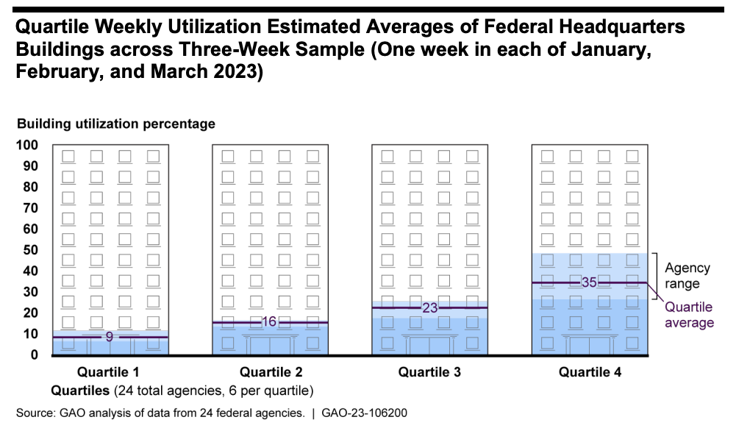by Brett Rowland
It’s time for the largest employer in the United States to rethink its 511 million square feet of office space, according to a congressional watchdog.
A report from the U.S. Government Accountability Office found that the federal government spends billions each year on underused office space. It recommended agency officials take another look at how much office space they need.
The federal government spends about $7 billion a year on office space. About $2 billion a year to operate and maintain federal office buildings and another $5 billion to lease office buildings.
“Any reduction in office space could reduce these costs,” according to the report.
The federal government employs about 2.25 million military employees (of whom about 1 million are reservists) and about 2.25 million civilian employees (of whom nearly 60% work for the Departments of Defense, Veterans Affairs and Homeland Security), according to the Congressional Budget Office. Walmart is the nation’s largest private employer. The retailer employed about 2.1 million people worldwide, with about 1.6 million employees in the U.S. at the end of fiscal year 2023.
“As the country emerges from the pandemic, the federal government has a unique opportunity to reconsider how much and what type of office space it needs,” according to the U.S. Government Accountability Office report.
Even before the pandemic, agencies “struggled to determine how much office space they actually needed,” according to the report.
The report looked at 21.5 million square feet of office space in the headquarters buildings of 24 federal agencies.
“Seventeen of the 24 federal agencies in GAO’s review used an estimated average 25% or less of their headquarters buildings’ capacity in a three-week sample period across January, February, and March of 2023,” according to the report. “On the higher range, agencies used an estimated 39% to 49% of the capacity of their headquarters on average.”
Remote working arrangements are part of the reason many of the buildings were underutilized, according to the report.
“All 24 agencies said that their in-office workforce has not returned to pre-pandemic levels due to increased use of telework and remote work,” according to the report. “Some agencies said that workplace flexibilities, such as episodic telework and remote work, existed before the pandemic but are used much more frequently now.”
“The pandemic has lowered the utilization of headquarters office space and may have added to the amount of unneeded space that existed prior to the pandemic,” David Marroni, acting director of the Government Accountability Office’s Physical Infrastructure Team, told a subcommittee. “While all agencies have resumed in-person operations, it is clear that the federal workplace has evolved as agencies have embraced hybrid and remote office environments. This moment presents a unique opportunity to reconsider various aspects of the federal government’s real property portfolio and how best to align the portfolio with future needs.”
– – –
Brett Rowland is an award-winning journalist who has worked as an editor and reporter in newsrooms in Illinois and Wisconsin. He is an investigative reporter for The Center Square.









